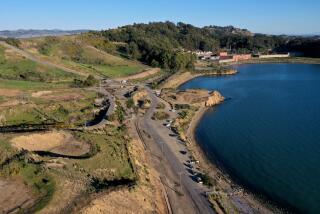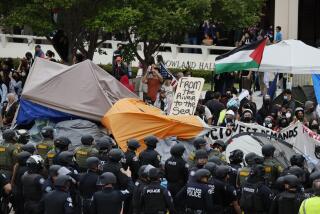CALIFORNIA ALBUM : Play Replaces Protests at People’s Park : After 23 years as the scene of social upheaval, the Berkeley site is now home to volleyball pits, a playground and a basketball court.
- Share via
BERKELEY — It has been a hectic, memorable 23 years marked by angry ultimatums, hateful words and some blood and tears.
But on a cool and serene Monday afternoon, the quintessential Berkeley landmark--People’s Park--finally became a real park.
Young men shot hoops on the ground where historic protest clashes of the 1960s were fought. Fresh sand filled the volleyball pits. As crews removed the fences and barbed wire, a new playground awaited the neighborhood tots.
John Yates, a 43-year-old homeless man who worked on the construction crew, and a buddy were the first to play on the new basketball court.
“I put a lot of sweat and time in here,” Yates said. “We want to . . . be the first ones to put a basket in.”
His friend, Harold Wiliams, sank the first two points. “I think it’s a cool project,” said Williams, 38. “It really adds to the park.”
The day passed without violence or official ceremony, perhaps a surprise given the history of the 2.8-acre piece of land three blocks from UC Berkeley.
Students in the late 1960s occupied the vacant lot intent on stopping the university from building a dormitory. They declared the site a landmark for free speech and gave it the name People’s Park.
In a face-off that drew national attention, then-Gov. Ronald Reagan called in the National Guard to liberate the park from its liberators. In a particularly violent protest in May, 1969, one person was killed, another blinded and about 200 people were injured.
The university then abandoned development plans. In the last decade, homeless people and drug peddlers took over the grounds. Few students dared set foot inside the park.
Three years ago, the city of Berkeley and the campus set out to beautify the site and turn it into a park that more people could enjoy.
But even that idea met with dissent. When construction crews arrived last July, new protests erupted. Police fired wooden dowels and plastic putty bullets to subdue the crowds that came to block the bulldozers.
More than 100 people were arrested, and a police officer suffered a broken jaw in the fracas. The protest spilled onto Telegraph Avenue, where looters smashed windows and wreaked havoc in the area near campus.
In the last round of protests in early March, Berkeley police arrested 24 people. But the opposition has slowly ebbed as the park’s new recreation facilities have gradually opened to the public.
When the last fences began to come down Monday, there was no official acknowledgment of what had come before.
“There’s no particular reason to have a ceremony,” said Milton Fujii, the campus’ director of community affairs. “It would be anticlimactic anyway. People want to use the park as soon as possible.”
But, this being Berkeley, the first jump shots on the new basketball courts were accompanied by some social commentary.
“The university’s priorities are ass backwards. I’d like to see the whole thing grassed over the way it was,” said Naja Strandt, 40, who took in the scene Monday as “a former homeless person.”
But even some of the homeless who were evicted from the park said they are not necessarily against the turn of events. After all, they have been known to enjoy a good game.
“I like volleyball, don’t get me wrong,” said Brian DeBord, a street person who is a regular in the sand pits. “But they put it in by force.”
To be sure, evidence of the old People’s Park remains: the “free box” where people drop off clothes for the homeless, and a small tree marked with a homemade sign honoring Martin Luther King Jr. A local charity serves free breakfasts to about 75 people every morning.
Campus and city officials say they have solved the problem of coexistence among the street people, students and neighbors, who all seem able to use the park together.
“Everyone is getting what they wanted out of People’s Park,” Fujii said. “It’s clear to anybody that there’s plenty of room on the park for all types of people and activity as long as its peaceful and legal.
But Andrea Pritchard, a 28-year-old Berkeley activist, had a warning for satisfied officials.
“Have they dealt with issues of crime, poverty, homelessness? As far as I can tell, those problems still exist in abundance,” she said.
More to Read
Sign up for Essential California
The most important California stories and recommendations in your inbox every morning.
You may occasionally receive promotional content from the Los Angeles Times.













